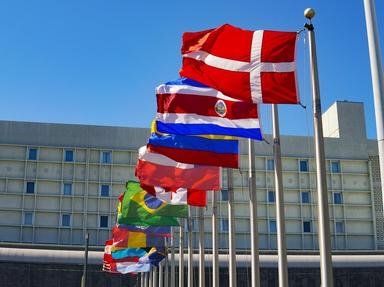Quiz Answer Key and Fun Facts
1. The picture shows the flag of the Republic of Ciskei, a nominally independent Bantustan state that existed from 1981 until 1994. Within which modern-day country was its territory?
2. The pictured flag belongs to the breakaway State of Katanga, which declared its independence in 1960. Its capital was the city of …lisabethville, which is now called Lubumbashi and is the capital of the Katanga Province and the second-largest city in which African country?
3. Unfortunately, the wonderful flag pictured here belonged to a state that lasted only six weeks. Declared in November 1897 with its capital at San Miguel in Bulacan province, the Republic of Biak-na-Bato was established during the revolution against the Spanish in which modern-day country?
4. The flag pictured here belonged to the Banten Sultanate, established in 1527 and lasting until 1813 when it was annexed to the Dutch East Indies. On which Asian island was this independent sultanate?
5. Founded in 1526 following Babur's victory in the first Battle of Panipat, this empire (which lasted more than three centuries) encompassed an area of more than 1.2 million square miles (about the size of modern-day India). The last remnants of which empire were taken over by Britain in the 1850s?
6. Founded by peasant rebels in 1644, it would be almost another half century before this absolute monarchy reached their zenith, at which point they controlled some 5.6 million square miles, an area larger than Antarctica. Which great dynasty/empire did the pictured flag represent?
7. No, it's not the alternative version for a "Jolly Roger", although it is rather scary. This was the flag of a fairly short-lived republic, lasting from 1755-1769. Indeed, use of the flag was virtually banned in 1769. Which European island declared itself independent and used the pictured flag?
8. Isn't this a truly superb flag? First settled sometime around 1200, most of the population of this independent state was wiped out by a combination of slave traders, smallpox and tuberculosis. The republic to whom the pictured flag belonged was annexed in 1888 and remains so still today. Which island nation once flew this flag?
9. Our next flag was the banner for a much more recent independent state. Just a few months after the breakup of the Soviet Union in March 1991, the Republic of Gagauzia and their neighbors, Transnistria, began moves to break away from their nominal nation. It was not until 1994 that the three autonomous regions settled their differences and agreed to proceed as which republic?
10. We finish with another very unusual flag: this belonged to the Republic of Ragusa, established in 1358. Protected by the Ottoman Empire through the 15th and 16th centuries, it survived as an independent city state until conquered by Napoleon in 1807. Over which modern-day city did this flag once fly?
Source: Author
EnglishJedi
This quiz was reviewed by FunTrivia editor
stedman before going online.
Any errors found in FunTrivia content are routinely corrected through our feedback system.

